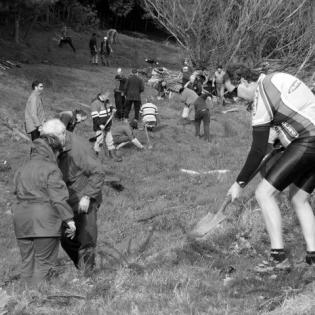Speaking for the Trees
In response to reading The Lorax, participants identify what trees give to us and all sectors of society. In response, we identify our personal responsibility for caring for trees.
- Describe the giving relationship between trees, people, and the environment.
- Name four sectors of society - family, business, government, and non-profit.
- read-aloud copy of The Lorax by Dr. Seuss
- chart paper and markers
- a single tree seed, such as a maple seed or acorn - or use an image (see Pinterest for a tree ID chart by seeds)
Optional: Secure a guest speaker from local nursery, garden club, county extension agency, or a parent gardener.
Reflect on the things family members do for the common good of the family. See handout: Family Support.
For a deeper discussion of the book, The Lorax, this Learning to Give literature guide provides before, during, and after reading discussion prompts and activities.
Dr. Seuss, The Lorax. Random House Books for Young Readers, 1971. ISBN 0394823370
Instructions
Anticipatory Set:
Hold up a single tree seed (such as a maple seed or acorn) and ask participants to imagine it is the future and this is the only tree seed left in the world because all of the trees have been cut down to build houses, paper, and other things people wanted. Ask what they should do to care for the seed.
Brainstorm a list of things that trees give us (and the environment), such as oxygen, wood, fruit, shade, a place to climb, a home for bugs, food for birds. Write the many ideas on half of a chart paper labeled "Trees Give Us."
Read aloud The Lorax by Dr. Seuss. During reading, discuss what the truffula trees were used for and why it got out of control. Ask the listeners to think of words describe the Oncler's behavior. Was he careless, selfish, greedy, short-sighted? Does his behavior remind listeners of ways we might act in our real-life society?
After reading, discuss the meaning of the word "unless" in the story.
Discuss what our responsibility is to the trees of the world (the real world). Make sure this includes learning about trees and telling others about their value.
The Once-ler asks us to care very much and take action to protect the trees. We can give our time, talent, voice, or treasure, as philanthropists, to take care of the environment. On the second half of the chart paper, brainstorm a list of things we can give to trees, such as space to grow, replanting, appreciation, water, and clean air.
Discuss the word "responsibility" as it relates to the environment. What happens in our home, school, neighborhood, and world if people take responsibility for the common good, not just themselves?
Optional: If the weather is nice, go outside to an area with trees and have an Earth Day scavenger hunt.
Explain to participants that a community can be divided into four sectors that work together for the good of all. Draw and label four quadrants on chart paper: Family, Business, Government and Nonprofit (Voluntary Sector). Define each word/sector. We need all four sectors to take care of all needs.
Choose one idea from the tree chart and together decide which sector uses or takes care the tree for that purpose (e.g., climbing trees is probably done by Family). Write it in the correct quadrant. In conversation, write the ideas from the first chart in the new chart. Sometimes the group may decide that a tree use fits in more than one category. Work out how to solve that problem (e.g., write it twice or make a Venn diagram).
Look at the completed chart together and discuss in which sector trees are important. Observe that trees are an important resource in many ways to many people and organizations (as illustrated in the book The Lorax) and that it is important for the sectors to work together and all take responsibility to protect the trees for the common good.
A project may include planting trees or advocating for the importance of trees. A local nonprofit may have volunteer opportunities related to planting and maintaining trees in the community.
Philanthropy Framework
-
Strand PHIL.I Definitions of Philanthropy
-
Standard DP 01. Define Philanthropy
-
Benchmark E.1 Define philanthropy as the giving and sharing of time, talent, or treasure intended for the common good.
-
Benchmark E.3 Recognize that citizens have a responsibility for the common good as defined by democratic principles.
-
Benchmark E.4 Define and give examples of selfishness and selflessness.
-
Benchmark E.5 Define the terms "profit" and "not-for-profit."
-
-
Standard DP 02. Roles of Government, Business, and Philanthropy
-
Benchmark E.1 Give examples of needs met by government, business, civil society, and family.
-
Benchmark E.4 Define each of the sectors: business, government, civil society, and family.
-
Benchmark E.6 Explain why acting philanthropically is good for the community, state, nation, or world.
-
-
Standard DP 06. Role of Family in Philanthropy
-
Benchmark E.2 Identify examples of families supporting giving and sharing.
-
-
-
Strand PHIL.II Philanthropy and Civil Society
-
Standard PCS 03. Philanthropy and Economics
-
Benchmark E.5 Recognize the wise use of resources as <i>stewardship</i>.
-
-
